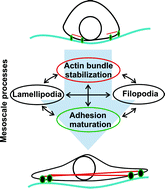Numerically bridging lamellipodial and filopodial activity during cell spreading reveals a potentially novel trigger of focal adhesion maturation†
Abstract
We present a novel approach to modeling cell spreading, and use it to reveal a potentially central mechanism regulating focal adhesion maturation in various cell phenotypes. Actin bundles that span neighboring focal complexes at the lamellipodium–lamellum interface were assumed to be loaded by intracellular forces in proportion to bundle length. We hypothesized that the length of an actin bundle (with the corresponding accumulated force at its adhesions) may thus regulate adhesion maturation to ensure cell mechanical stability and morphological integrity. We developed a model to test this hypothesis, implementing a “top-down” approach to simplify certain cellular processes while explicitly incorporating complexity of other key subcellular mechanisms. Filopodial and lamellipodial activities were treated as modular processes with functional spatiotemporal interactions coordinated by rules regarding focal adhesion turnover and actin bundle dynamics. This theoretical framework was able to robustly predict temporal evolution of cell area and cytoskeletal organization as reported from a wide range of cell spreading experiments using micropatterned substrates. We conclude that a geometric/temporal modeling framework can capture the key functional aspects of the rapid spreading phase and resultant cytoskeletal complexity. Hence the model is used to reveal mechanistic insight into basic cell behavior essential for spreading. It demonstrates that actin bundles spanning nascent focal adhesions such that they are aligned to the leading edge may accumulate centripetal endogenous forces along their length, and could thus trigger focal adhesion maturation in a force–length dependent fashion. We suggest that this mechanism could be a central “integrating” factor that effectively coordinates force-mediated adhesion maturation at the lamellipodium–lamellum interface.


 Please wait while we load your content...
Please wait while we load your content...